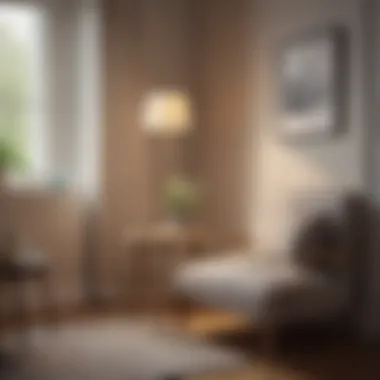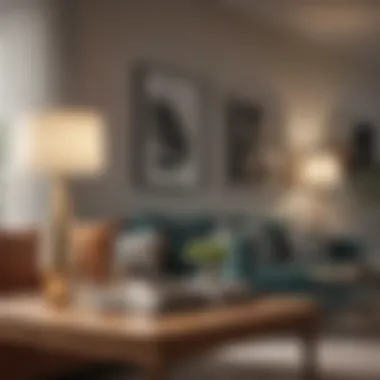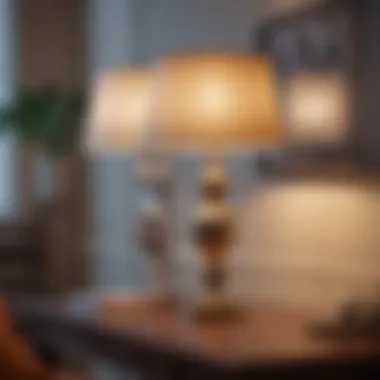The Role of Small Table Lamps in Modern Interiors


Intro
When it comes to interior design, the atmosphere of a space can often be defined by the choices we make, especially in lighting. Small table lamps, though sometimes overlooked, wield a significant impact on how we experience our living areas. These compact fixtures can transform the functionality and aesthetics of a room, adding both style and warmth. In this article, we'll unravel the nuances of small table lamps, focusing on their role as functional decor and how to choose the right pair for your unique ambiance.
Furniture Design Styles
Overview of Popular Styles
Table lamps come in all shapes and sizes, reflecting diverse design inspirations ranging from mid-century modern to industrial chic. Understanding these styles is essential, as it allows homeowners and designers alike to select lamps that harmonize with existing decor.
- Mid-Century Modern: Characterized by clean lines and organic shapes, these lamps often feature materials like wood and metal. A colorful ceramic base can add a splash of personality.
- Industrial: Raw metals, exposed bulbs, and rustic features define this style. Think of a lamp resembling a factory piece, perfect for lofts or eclectic homes.
- Scandinavian: Minimalistic and functional, Scandinavian lamps often emphasize natural materials and neutral colors, providing a serene lighting solution.
- Traditional: These lamps boast of ornate designs, rich fabrics, and classic shapes. Ideal for spaces with classic decor, they can evoke a sense of timeless elegance.
Each design style serves a purpose and conveys a message about the homeowner's tastes. By aligning your table lamps with your chosen furniture style, you can create a cohesive visual narrative throughout your space.
How to Mix and Match Styles
Mixing styles can seem daunting, but it can lead to fascinating results. A well-placed small table lamp can act as the perfect bridge between different decor elements. Here are some tips to get started:
- Choose a Common Element: Find a color or material that links differing styles. For instance, matching the brass trim of an industrial lamp with other brass accents in the room can create a seamless transition.
- Balance Proportions: When mixing styles, pay attention to size and shape. Ensure that larger, bulkier lamps are balanced with lighter, more streamlined pieces to avoid a chaotic feel.
- Layer Lighting: Use table lamps alongside other light sources such as floor lamps or wall sconces to establish depth and layering in your lighting scheme.
- Test it Out: Sometimes, the best way to assess whether a lamp fits is simply to try it in the space, adjusting until it feels just right.
By thoughtfully considering your design styles, you can enhance your interior while enjoying the benefits of effective lighting.
Practical Tips for Homeowners
Essential Buying Tips
Investing in small table lamps can be a somewhat tricky endeavor. Before you dive in, keep these factors in mind:
- Consider Purpose: What will the lamp be used for? Task lighting is vital for reading nooks, while ambient lighting is crucial for creating a cozy atmosphere.
- Size Matters: Ensure the lamp is proportionate to the furniture it accompanies. A hefty lamp on a dainty side table will feel off-balance.
- Shade Types: The lamp shade influences the quality of light. A white shade will provide a brighter, more focused light, while darker shades can create a mellower glow.
- Energy Efficiency: Opting for LED bulbs can save both energy and costs in the long run. Plus, they come in various color temperatures to match your desired ambiance.
Maintenance and Care Guidelines
To keep table lamps looking pristine and functioning well, regular maintenance is key. Follow these simple guidelines:
- Dust Regularly: A soft cloth can keep your lamp free of dust; this is especially important for shades that can easily show dirt.
- Check for Damage: Monitor cords and switches for wear and tear. If a lamp isn't functioning properly, don’t hesitate to replace the bulb or seek professional repair if necessary.
- Avoid Overheating: Ensure lamps are not in areas where they can easily overheat. Avoid placing them too close to curtains or flammable decor.
Taking proper care can make your small table lamps an enduring asset to your space, adding both beauty and functionality for years to come.
Remember: Small table lamps are more than just light sources; they are integral components of your interior design that should reflect your style, needs, and the mood you wish to create in your home.
With these insights, you're poised to explore new dimensions in your interior spaces, turning ordinary corners into captivating areas of light.
The Role of Small Table Lamps
Small table lamps have carved a notable niche in interior design, acting as both practical aids and aesthetic gems in various spaces. Their versatility allows them to fit into nearly any style, be it traditional or modern, highlighting the importance of lighting in our homes. These lamps do more than just brighten a corner; they create an atmosphere and define the character of a room. Having a nuanced understanding of how these fixtures contribute to both form and function is crucial for designers, homeowners, and decorators alike.
Functional Design Elements
When it comes to functional design, small table lamps offer a smorgasbord of features. Firstly, they serve as a reliable source of child-friendly task lighting. Positioning them strategically can illuminate spaces where activities like reading or crafting take place, diminishing shadows and enhancing visibility. Consider this: a well-placed small table lamp next to a cozy reading chair can turn an average corner into a cherished nook, naturally encouraging people to pour over books.
Moreover, ease of use is another consideration. Many come with dimmers or adjustable heights, allowing users to customize the lighting according to their needs. This adaptability not only caters to various activities but also creates an inviting environment. You could say it’s like having a Swiss Army knife for lighting – versatile and helpful in many scenarios.
An additional perk is the mobility of these lamps. Unlike overhead lighting that can be a Herculean task to reposition, small table lamps can be effortlessly shifted from one place to another, offering a fresh outlook. For instance, if you have guests over, moving a lamp from one side of a console table to the other can instantly change the room's dynamics.
Aesthetic Enhancements
Just as functional as they are, small table lamps are also powerful players in the aesthetic game. They introduce pops of color, texture, and shape, which can break the monotony of a room filled with neutral tones. Choosing a lamp with a patterned shade or a unique base can steer the design in a distinctly different direction. It’s like that little black dress that can be styled multiple ways – it adds elegance without needing a complete overhaul of the space.
The design of a small table lamp can set a tone that resonates throughout a room. For example, a chic metallic lamp might elevate a modern workspace, while a rustic ceramic piece can bring warmth to a farmhouse kitchen. These small details accumulate, often influencing our overall mood within a space.


Additionally, the light itself plays a crucial role in how interior elements perceive each other. Light can soften hard edges or emphasize textures, creating an inviting aura. The glow from a small table lamp can highlight a beautiful piece of art or create a waning light that promotes relaxation during those quiet hours at home.
"Lighting is more than just a functional component; it’s a tool for shaping how we experience our surroundings."
Styles of Small Table Lamps
When it comes to choosing small table lamps, style plays a crucial role. These fixtures are not just about providing light; they can also dramatically influence the aesthetics of a space. Each style brings its own flavor to a room, creating an atmosphere that can enhance mood and functionality. Let's dive into a few trending styles and what makes them stand out.
Modern Minimalism
In today's fast-paced world, many people gravitate towards modern minimalism. This style emphasizes simplicity and functionality, stripping away excess to focus on clean lines and elegant forms. Small table lamps in this category often feature neutral colors like white, black, or grey, allowing them to blend seamlessly into their surroundings.
The beauty of a modern minimalist lamp lies in its understated elegance. Imagine a sleek, cylindrical black lamp sitting on a light wood side table – it enhances the room's sophistication without overpowering it. The focus remains on the quality of light and the space it illuminates, instead of the lamp itself. This style is perfect for anyone who values a clutter-free, contemporary atmosphere in their home.
Classic Elegance
Classic elegance is about timeless beauty. These lamps often feature rich materials like brass, crystal, or porcelain, showcasing intricate designs and details. A classic lamp can instantly add a touch of luxury to any room. For example, picture a delicate crystal table lamp casting shimmering reflections across a polished wood desk. This kind of lamp can elevate a space into one that feels both warm and opulent.
The benefit of classic elegance in small table lamps is their ability to fit into various decor styles. Whether it's a traditional, eclectic, or even a modernized classic space, these lamps bring a sense of history and charm, making them a versatile choice.
Industrial Chic
Industrial chic has surged in popularity in recent years, characterized by raw materials and a somewhat rugged aesthetic. Small table lamps in this style often incorporate metal, wood, and even exposed bulbs, creating an edgy yet inviting atmosphere. Picture a lamp with a distressed metal shade and a wooden base – it tells a story of craftsmanship and creativity.
The appeal of industrial chic lamps lies in their ability to blend with a variety of themes, from urban lofts to cozy farmhouse settings. They invoke a sense of authenticity and make a statement without being overly flashy. For those who appreciate the beauty of utility and the allure of the unfinished, this style is a go-to.
Bohemian Touch
For those drawn to a more eclectic vibe, bohemian-style lamps bring vibrancy and personality into play. These lamps often draw inspiration from various cultures and can include colorful shades, unique shapes, and artisan-crafted bases. Picture a lamp adorned with a fabric shade in vivid patterns, resting on a stack of vintage books – it's a conversation starter and a centerpiece.
Bohemian lamps invite creativity and an individualistic approach to decor. They allow homeowners to express their personal style while adding a playful touch to their space. If you want your room to feel lively and unique, exploring the bohemian style could be the perfect path.
Small table lamps not only light up a room but also reflect the personality of its inhabitants. Choosing a style that resonates deeply with your tastes can greatly enhance your living environment.
Choosing the Right Pair
When it comes to small table lamps, selecting the right pair isn't just a matter of picking what's visually appealing; it’s about harmonizing function and flair. The right lamps can add a layer of depth to a room, contributing to the overall spatial experience. Their placement and visual cohesion can significantly affect the mood and ambiance of any space, making this choice pivotal in today’s design landscape.
Height Considerations
Height plays a crucial role when choosing small table lamps. The ideal height of a lamp often depends on its intended use and the surrounding furniture. For instance, lamps flanking a sofa should typically stand around eye level when seated, often between 24 and 34 inches. This ensures that they illuminate the area effectively without dominating the visual field. If you're considering a reading nook, perhaps a slightly taller lamp may serve you better, allowing for focused light while keeping it comfortably accessible.
It's also wise to consider the height of the table or surface. A tall lamp on a low surface can seem out of balance, while a short lamp on a high bookshelf might not deliver the desired light. Striking a balance is key.
Color Coordination
Color coordination can make or break the aesthetic flow of a room. For small table lamps, the goal is to achieve a cohesive look that enhances the existing decor. If your room is already rich in color, a neutral lamp can anchor the space, providing a visual resting point amidst the hues. Conversely, a vibrant lamp can energize a muted palette, becoming a focal point in itself.
When selecting lamp colors, think about the overall theme of the room. Warm colors may create a cozy feel, perfect for living areas, while cool colors can lend a more tranquil vibe, suited for bedrooms or home offices.
Placement Strategies
The strategic placement of small table lamps can significantly affect the atmosphere and functionality of a space. It’s not just about finding a flat surface to set them down; the way these lamps are positioned can either enhance the decor or throw it out of balance. A little thought can go a long way in making sure that these light sources serve both practical and aesthetic purposes.
When considering where to place a lamp, think about how the light will interact with other elements in the room. Good placement can create a cozy nook for reading, balance visual weight, or draw attention to artwork or features on the wall.
Living Room Ambiance
In the living room, table lamps can create a welcoming vibe. Placing lamps on side tables adjacent to sofas can provide a soft glow, perfect for evenings spent unwinding with a book or watching a movie. Think of the overall layout — if you have a sectional couch, aligning lamps with the ends can create symmetry. Moreover, you might want to use varying heights by mixing a taller lamp with shorter ones to avoid a flat look. Consider also positioning a lamp near a plant or piece of art. This not only highlights those features but creates layers in your lighting that feel lively and inviting.


Bedroom Settings
The bedroom is a sanctuary where lighting plays a crucial role in mood-setting. Small table lamps can be placed on nightstands to provide soft illumination for bedtime reading or intimate conversations. The height of the lamp is an important consideration; it should be at a level that’s comfortable for use while in bed. Softer hues and lower wattage bulbs are ideal here to ensure an atmosphere that promotes relaxation. A little trick is to use two lamps on either side of the bed, as this not only balances the space visually but also provides options for both occupants, allowing for personalized light settings.
Home Office Utilization
In a home office, the placement of lamps can enhance productivity and focus. Consider a small lamp on your desk where you do most of your work. This provides task lighting necessary for reading documents or typing on a keyboard without straining your eyes. Beyond the desk, having a lamp in a corner can help light up the entire space without being overly harsh. It’s crucial to ensure that the light isn’t glaring on your screen or reflecting harshly off surfaces. Balance is key, and using a lamp to counter natural light from a window can help in achieving the right ambiance.
The careful placement of small table lamps transforms not just the visibility but also the emotional response to a space.
With a little creativity, the right placement strategies can elevate a room from standard to stunning. Remember, the objective is to augment the existing decor while fulfilling specific functional roles. Depending on your room’s character and your personal style, there’s always a perfect spot waiting for your lamps.
Functional Benefits of Lighting
Lighting serves as a linchpin in interior design. It is not just about illuminating a space; it’s about enhancing the usability and aesthetics of that space. When it comes to small table lamps, understanding their functional benefits can greatly elevate how we perceive and utilize our interiors. Small table lamps can do wonders in different settings, making them pivotal in crafting a well-rounded design scheme.
Task Lighting
Task lighting is particularly crucial for activities that require focus and precision such as reading, writing, or working on hobbies. A small table lamp can provide direct light where it’s most needed. When placed on a desk or beside a comfy chair, it ensures the glow of the lamp won’t cast shadows, making any task less taxing on the eyes.
- Adjustability: Many small lamps offer customizable brightness or adjustable arms that allow you to direct light exactly where it is needed. This flexibility is essential for creating comfortable workspaces.
- Energy Efficiency: With the rise of LED bulbs, task lighting solutions have become more energy-efficient, generating less heat and using only a fraction of the power compared to traditional bulbs.
- Space-Saving: Often designed compactly, these lamps fit seamlessly into tight spaces without sacrificing efficiency. In a cramped home office or reading nook, a small table lamp can be both stylish and effective.
Ambient Lighting
Beyond task lighting, ambient lighting plays a significant role in shaping the overall mood of a room. Small table lamps create a warm, inviting atmosphere, which can dramatically influence how a room feels.
- Layering Light: Ambient lighting derived from small lamps works in harmony with other types of lighting, such as overhead fixtures. Layering light creates depth and warmth, transforming a stark space into a sanctuary.
- Color Temperature: The choice of bulb can affect the ambiance. Warmer tones create a cozy atmosphere, while cooler tones can energize a space. Small table lamps allow you to experiment with different colors within specific areas of your home.
- Strategic Placement: Thoughtfully placed, these lamps can illuminate darker corners or highlight wall art, significantly enhancing the perception of space.
"The right light can make a world of difference in how a room is experienced."
Trends in Table Lamp Design
In today's fast-paced world, the trends in table lamp design are not merely about illumination; they reflect broader shifts in lifestyle, sustainability, and technology. Small table lamps have become essential tools for interior designers, retailers, and homeowners alike. These trends serve as a testament to the evolving tastes and preferences of consumers, offering insights into what shapes our living spaces.
When it comes to trends, understanding the pulsating undercurrents can help inform choices that not only enhance aesthetic appeal but also fulfill practical needs. With sustainability gaining notable traction, the importance of small table lamps in this context cannot be overstated; they symbolize how conscious consumerism can harmonize with style.
Another critical aspect of modern table lamp trends is the integration of smart technology. With lives becoming increasingly digitized, lamps that can adapt to individual preferences and automatically adjust brightness and color are becoming more desirable. This merging of functionality and convenience is anything but trivial; it’s a sign of the times we are living in.
Sustainable Practices
Sustainable practices in table lamp design are taking the industry by storm. As consumers become more environmentally conscious, designers are stepping up to the plate by offering products that minimize ecological impact. The use of materials sourced from recycling plants, for instance, shows a commitment to reducing waste.
Some small lamp designers are even making use of reclaimed wood or repurposed metal, creating a unique fusion of practicality and artistry. Beyond materials, the advent of energy-efficient bulbs is a game changer. Choosing LED bulbs over traditional ones drastically cuts down on electricity consumption. It’s about making informed choices that don’t just illuminate the home but also lessen our carbon footprint.
"Incorporating sustainable practices in lighting not only enhances your space but also nurtures the planet."
Consider these options when selecting the right table lamp:
- Use LED bulbs: They are long-lasting and energy-efficient.
- Select furniture made from recycled materials: It adds character and environmental sensibility to your decor.
- Opt for manufacturers with eco-certifications: This can ensure that your choices align with sustainable manufacturing practices.
These small decisions compound to have a significant impact, transforming how we perceive interior design in the long run.
Smart Technology Integration
The wise adoption of smart technology in table lamp design is a growing trend that should not be overlooked. It’s no longer about just switching a lamp on or off; it’s about intelligent lighting that adapts to various needs and contexts. Smart lamps come equipped with features like remote control capability, voice activation, and even app integration, allowing users to customize their lighting environment.
Imagine coming home after a long day; with a simple voice command, your lamps adjust to your preferred brightness and color temperature. This kind of convenience speaks volumes about how smart technology is reshaping our living spaces. Designers are embracing this shift by creating stylish, tech-savvy lamps that are as much a statement piece as they are functional.
Some added benefits of integrating smart technology include:
- Energy savings: Automated settings can reduce electricity waste.
- Customization: Create different lighting moods for various occasions with just a few taps.
- Convenience: Schedule your lamps to turn on or off automatically, easing into your routine.


In sum, these trends reflect a significant departure from merely functional design to a more harmonious blend of beauty, tech, and environmental awareness. Whether it’s adapting to a sustainable lifestyle or embracing smart solutions, table lamps have firmly established themselves as pivotal elements in the canvas of modern interior design.
Integrating Lamps into Home Decor
Integrating small table lamps into home decor is far more than just putting a light source on a side table. It's about how their presence affects the overall atmosphere, mood, and style of a space. Table lamps serve a dual purpose: they illuminate and contribute to the room’s aesthetic appeal. Whether you’re a designer or a homeowner, understanding the nuances of lamp integration can turn an ordinary room into something truly special.
Layering Light Sources
When we talk about lighting, layering is a vital concept. Think of it this way: a single light source can feel flat and uninviting, while multiple sources create depth and warmth. Small table lamps can be a crucial part of this lighting strategy. You could hang an overhead fixture but adding small lamps offers localized lighting, crucial for tasks like reading or working.
Here are some key points to consider:
- Mix and Match: Use a combination of table lamps with overhead lighting and natural light. This variation can balance the room and create inviting spaces.
- Ambiance Control: In the evenings, when the sun dips, small table lamps can provide a cozy atmosphere. Dimming your overhead lights while keeping your lamps on can create a lovely contrast.
- Functional Zones: If you have open spaces, like a living room that flows into the dining area, place lamps in different zones. This can clearly delineate spaces without walls.
Creating Focal Points
A well-placed lamp can draw the eye and direct attention within a room. Each of your lamps shouldn’t just be functional; they should also speak to the design narrative you’re creating. Larger lamps can serve as statement pieces, anchoring furniture arrangements or complementing artwork. Consider these aspects:
- Height Matters: The height of your lamp can significantly affect how it draws the eye. A tall lamp next to a low sofa can create a visual anchor, guiding your gaze around the room.
- Color and Texture: Don’t just focus on the light; consider the lamp itself. A lamp with a unique texture or color can act not only as a light source but as a piece of decor in its own right.
- Layer with Decor: Create layers by situating your lamp near other decor elements like books, vases, or even personal memorabilia. This integration adds interest and makes the lamp feel integrated rather than an afterthought.
"Lighting isn’t just a utility; it has the power to shape our experiences in a space."
Maintenance and Care
The maintenance and care of small table lamps is often overlooked when discussing their role in interior design. However, keeping these fixtures in top shape is essential for functionality and aesthetic appeal. Regular upkeep ensures that the lamps not only look good but also perform optimally, contributing to the overall ambiance of your space.
Dusting and Cleaning
Dust and dirt can accumulate on every surface, and small table lamps are no exception. Dust can diminish the quality of light they emit and detract from their visual appeal. The good news is that cleaning them is a straightforward task.
To begin, it’s wise to turn off the lamp and unplug it from the socket before cleaning. Start with a microfiber cloth to gently wipe the lampshade and base. For fabric shades, a soft brush attachment on your vacuum can do wonders—just be gentle, as you don’t want to damage the fabric. If the lampshade is plastic or glass, a damp cloth with a mild detergent will suffice. Don't forget to check for any hard-to-reach spots, including the crevices around the bulb socket.
"An ignored lamp can cast more shadows than just on your wall; it can impact your mood too."
Bulb Replacement Guidelines
Replacing bulbs in small table lamps is not only a care task but also a key component in maintaining effective lighting in a room. Over time, bulbs can lose their brightness or burn out completely, leaving your space dimmer than a cloudy day. Understanding when and how to replace these bulbs is important.
Typically, it’s good to check your bulbs every few months. A flickering light often indicates that a bulb is nearing the end of its life. When it’s time for a change, make sure you’re using the right type of bulb. Incandescents, CFLs, and LEDs all have different requirements.
- Unplug the lamp before replacing the bulb.
- Allow the bulb to cool down for safety.
- If the bulb has a screw base, simply turn it counterclockwise to remove. For pin-style bulbs, gently pull straight out.
- Insert the new bulb and ensure it fits securely before plugging the lamp back in.
Maintaining the small table lamps in your home not only prolongs their life but also ensures your design remains immaculate and inviting.
Culmination and Future Directions
As we wrap up our exploration into the role of small table lamps in interior design, it’s vital to highlight how these modest yet influential objects can shape our living spaces. They don’t just illuminate; they transform the very atmosphere of a room, subtly interweaving functionality with aesthetics. Understanding their importance is key for designers, retailers, and homeowners alike. Thoughtful choices in lamp selection can evoke emotions and set the mood, bridging the gap between utility and artful design.
Reflecting User Preference
In this modern age, where personal taste dictates much of our design choices, small table lamps have evolved to reflect user preferences more than ever. Each individual brings their own flair, choosing lamps that speak to their specific desires and lifestyles. Whether it’s selecting a contemporary piece that aligns with minimalistic values or picking a vintage lamp that adds character to a space, the decision is a personal expression.
When shopping for lamps, trends also play a role. Some users might gravitate towards eco-friendly materials or smart technology features. For instance, it’s common now for many to integrate adjustable brightness or color-changing capabilities into their selection, catering to evolving needs and preferences. This ongoing evolution not only shapes personal spaces but also creates a dialogue between the user and the environment they inhabit.
"The little things can have a profound impact on the overall feel of a space. Small design elements, like table lamps, can be delightful conversation starters."
The Evolution of Lighting Design
The world of lighting design has witnessed significant shifts over the decades. In earlier times, functionality was the primary goal—ensuring that spaces were adequately lit for daily tasks. Today, the landscape has changed significantly. Small table lamps have transitioned from simple illumination tools to vital design components rich with style and innovation.
The integration of technology is particularly noteworthy. With the rise of LED bulbs, the energy-efficient shift has largely influenced design choices—lamps can now be both aesthetically pleasing and practical to maintain. Moreover, smart home integrations allow lamps to be controlled remotely, meeting the needs of a tech-savvy generation.
Another compelling factor is the movement toward sustainable materials. Consumers increasingly seek out lamps made from recycled or ethically sourced components. This shift not only emphasizes the aesthetic quality of the lamps but reinforces a commitment to sustainability in design practices.
In examining the unique journeys of table lamps, it’s clear that they have come to symbolize more than mere light sources—they are reflections of societal changes, user preferences, and advancements in technology. As we look to the future, it will be intriguing to observe how these trends continue to evolve and influence the realm of interior design.















